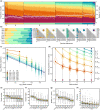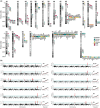Archetypes of inflorescence: genome-wide association networks of panicle morphometric, growth, and disease variables in a multiparent oat population
- PMID: 36106985
- PMCID: PMC9910404
- DOI: 10.1093/genetics/iyac128
Archetypes of inflorescence: genome-wide association networks of panicle morphometric, growth, and disease variables in a multiparent oat population
Abstract
There is limited information regarding the morphometric relationships of panicle traits in oat (Avena sativa) and their contribution to phenology and growth, physiology, and pathology traits important for yield. To model panicle growth and development and identify genomic regions associated with corresponding traits, 10 diverse spring oat mapping populations (n = 2,993) were evaluated in the field and 9 genotyped via genotyping-by-sequencing. Representative panicles from all progeny individuals, parents, and check lines were scanned, and images were analyzed using manual and automated techniques, resulting in over 60 unique panicle, rachis, and spikelet variables. Spatial modeling and days to heading were used to account for environmental and phenological variances, respectively. Panicle variables were intercorrelated, providing reproducible archetypal and growth models. Notably, adult plant resistance for oat crown rust was most prominent for taller, stiff stalked plants having a more open panicle structure. Within and among family variance for panicle traits reflected the moderate-to-high heritability and mutual genome-wide associations (hotspots) with numerous high-effect loci. Candidate genes and potential breeding applications are discussed. This work adds to the growing genetic resources for oat and provides a unique perspective on the genetic basis of panicle architecture in cereal crops.
Keywords: Avena; GWAS; NAM population; Plant Genetics and Genomics; TILLING population; archetype analysis; high-throughput phenotyping; image analysis; panicle; plant architecture; spikelet.
Published by Oxford University Press on behalf of Genetics Society of America 2022.
Conflict of interest statement
Conflicts of interest: None declared.
Figures




Similar articles
-
Genomic strategies to facilitate breeding for increased β-Glucan content in oat (Avena sativa L.).BMC Genomics. 2025 Jan 14;26(1):35. doi: 10.1186/s12864-024-11174-5. BMC Genomics. 2025. PMID: 39810135 Free PMC article.
-
A genome-wide association study using a Vietnamese landrace panel of rice (Oryza sativa) reveals new QTLs controlling panicle morphological traits.BMC Plant Biol. 2018 Nov 14;18(1):282. doi: 10.1186/s12870-018-1504-1. BMC Plant Biol. 2018. PMID: 30428844 Free PMC article.
-
Genome-wide association and high-resolution phenotyping link Oryza sativa panicle traits to numerous trait-specific QTL clusters.Nat Commun. 2016 Feb 4;7:10527. doi: 10.1038/ncomms10527. Nat Commun. 2016. PMID: 26841834 Free PMC article.
-
Genotyping-by-Sequencing and Its Application to Oat Genomic Research.Methods Mol Biol. 2017;1536:169-187. doi: 10.1007/978-1-4939-6682-0_13. Methods Mol Biol. 2017. PMID: 28132151 Review.
-
Puccinia coronata f. sp. avenae: a threat to global oat production.Mol Plant Pathol. 2018 May;19(5):1047-1060. doi: 10.1111/mpp.12608. Epub 2017 Dec 10. Mol Plant Pathol. 2018. PMID: 28846186 Free PMC article. Review.
Cited by
-
Genomic strategies to facilitate breeding for increased β-Glucan content in oat (Avena sativa L.).BMC Genomics. 2025 Jan 14;26(1):35. doi: 10.1186/s12864-024-11174-5. BMC Genomics. 2025. PMID: 39810135 Free PMC article.
-
Highlighting plant science with a GENETICS and G3 series on Plant Genetics and Genomics.Genetics. 2023 Feb 9;223(2):iyad003. doi: 10.1093/genetics/iyad003. Genetics. 2023. PMID: 36757897 Free PMC article. No abstract available.
-
A global assembly of landrace oat (Avena sativa L.) accessions is a discovery resource for adaptive variation, association mapping, and trait deployment.G3 (Bethesda). 2025 Jun 4;15(6):jkaf093. doi: 10.1093/g3journal/jkaf093. G3 (Bethesda). 2025. PMID: 40273399 Free PMC article.
-
Highlighting plant science with a GENETICS and G3 series on Plant Genetics and Genomics.G3 (Bethesda). 2023 Feb 9;13(2):jkad010. doi: 10.1093/g3journal/jkad010. G3 (Bethesda). 2023. PMID: 36758216 Free PMC article. No abstract available.
-
Genome-wide association studies reveal genetic control of nutritional quality, milling traits, and agronomic characteristics in oat (Avena sativa L.).Plant Genome. 2025 Sep;18(3):e70060. doi: 10.1002/tpg2.70060. Plant Genome. 2025. PMID: 40623918 Free PMC article.
References
-
- Admassu-Yimer B, Gordon T, Harrison S, Kianian S, Bockelman H, Bonman JM, Esvelt Klos K.. New sources of adult plant and seedling resistance to Puccinia coronata f. sp. avenae identified among Avena sativa accessions from the national small grains collection. Plant Dis. 2018;102(11):2180–2186. - PubMed
-
- Altschul SF, Gish W, Miller W, Myers EW, Lipman DJ.. Basic local alignment search tool. J Mol Biol. 1990;215(3):403–410. - PubMed
Publication types
MeSH terms
LinkOut - more resources
Full Text Sources

